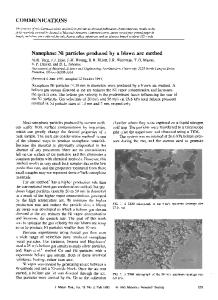Structure of Nanophase Gold Particles on Iron Oxide Supports
- PDF / 2,667,651 Bytes
- 6 Pages / 414.72 x 648 pts Page_size
- 87 Downloads / 367 Views
STRUCTURE OF NANOPHASE GOLD PARTICLES ON IRON OXIDE SUPPORTS B. G. DEMCZYK*, CHIEN SZE** AND ERDOGAN GULARI* *Electron Microbeam Analysis Laboratory, **Department of Chemical Engineering, The University of Michigan, Ann Arbor, MI 48109 ABSTRACT Ultra-fine gold particles supported on iron oxide have been synthesized by coprecipitation and subsequently heat treated in air at temperatures ranging from 200'C to 700'C. Structure analyses have revealed variations in the degree of crystallinity of the iron oxide support as well as gold particle size and size distribution with heat treatment temperature. In addition, lattice parameters of gold particles were observed to deviate up to ten percent from the bulk value. We discuss these observations in light of a total minimization of the energy of the system (support plus particles). INTRODUCTION Based on the thermochemical properties of certain elements and compounds, a number of materials, comprised principally of a noble metal supported on a reducible oxide, have been evaluated in the development of effective low temperature CO oxidation catalysts. Marked enhancement in activity for low temperature CO oxidation (1% CO) has been observed 1-6 in several transition metal oxide-supported gold systems (i.e.- Fe203, NiO, and Co304) prepared by coprecipitation. The work of Haruta et al. 1,2 in particular, has drawn attention to oxidesupported gold as a model system for studying metal-support interactions. The precise reasons for this synergism are still unclear at this time. To this point, only limited structural investigations have been undertaken of the gold/iron oxide system 7 , few on an atomic scale. In this work, we have examined the structural details of a number of coprecipitated gold on iron oxide catalysts subjected to different pretreatment temperatures, at resolutions up to the atomic level. EXPERIMENTAL Gold on iron oxide (atomic ratio Au/Fe=l/19) was prepared by the coprecipitation method, using hydrogen tetrachloroaurate trihydrate (Aldrich), ferric nitrate (Fischer Scientific), and sodium carbonate (J.T. Baker). The coprecipitate formed was collected and washed thoroughly in boiling deionized water for chlorine removal. Subsequently, the coprecipitate was dried and heat treated in air for four hours at temperatures in the range of 2000 to 700'C. Powder X-ray diffraction (XRD) was undertaken using a Rigaku DMAX-B diffractometer employing monochromatic CuKox radiation. Gold particle size and lattice parameters were deduced by high resolution transmission electron microscopy (HREM). Samples for transmission electron microscopy were prepared by gently grinding and ultrasonically dispersing the synthesized powders in isopropanol. The solution was then dispersed onto a holey carbon coated 3 mm diameter Cu mesh grid, via a pipette. High resolution transmission electron microscopy was performed at 400 kV, using a JEOL 4000 EX transmission electron microscope, with a point-topoint resolution of
Data Loading...











